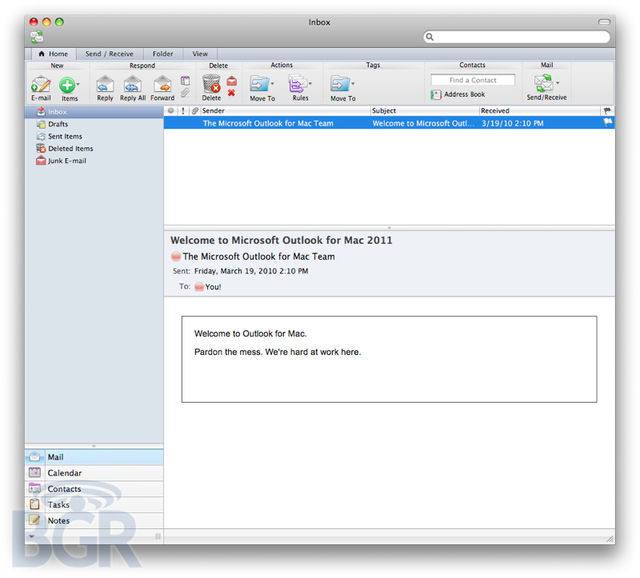Office 2011 For Apple Mac
Before installing Office 2011 for Mac, find hard drive errors by using your Mac’s Disk Utility program. The Disk Utility can detect errors in system file permissions and verify the file structure. Using the Apple Disk Utility may sound rather technical, but it’s actually quite easy.
If you have a good disk maintenance and repair utility (such as Alsoft DiskWarrior, TechTools Pro, Drive Genius, or a similar program), be sure to use it on your startup volume and other drives before installing a big product such as Microsoft Office. At a minimum, make sure your startup disk verifies as OK with Apple’s Disk Utility program.
Here’s how to check your hard drive with Disk Utility:
Outlook 2011 for Mac Basics. New to Office 2011 for Mac is Outlook 2011. With Outlook 2011 for Mac, you can manage and manipulate your e-mail, calendar, and contacts with these shortcuts: E-mail: Outlook 2011 supports IMAP, POP, and Exchange protocols. To switch to Mail view, press Command-1. Read our complete review of the 21.5- and 27-inch iMacs (mid-2011) Mac Pro. Oh, the Mac Pro. Apple hasn’t updated this workstation since August 2010. Rumor has it that Apple may stop making the.
In Finder, choose Applications→Utilities→Disk Utility Application.
In the panel on the left side, select your startup disk.
Your startup disk is the one at the top of the list of volumes. Select either the first or second item in the list.
On the First Aid tab, click the Verify Disk button.
Progress update messages and a progress bar appear. The bigger your hard drive is and the more files you have, the longer Disk Utility will take.
When the process is complete, quit the Disk Utility application.
The message you hope to see when Disk Utility is finished is green and says, “The volume [name] appears to be OK.” Most likely you will get this go-ahead, and you can proceed directly to installing Office and skip the next steps.
If the Disk Utility indicates that your disk needs to be repaired, the Repair Disk button will remain grayed out, and you need to take additional actions.
You can find additional instructions by doing the following:
In Disk Utility, choose Help→Disk Utility Help.
The Disk Utility Help window displays.
Choose Repairing a Disk.
Follow instructions for repairing your disk(s).
Sometimes Disk Utility can’t repair a disk. If that happens to you, don’t despair. Instead, try using another disk repair utility, such as Alsoft DiskWarrior, TechTools Pro, Drive Genius, or similar programs. They can find and repair more problems than Disk Utility can.
Don’t install Office until Disk Utility or another reliable maintenance and repair utility tells you that your startup disk appears to be okay. If your startup disk isn’t okay, Office may not run properly.
Microsoft Office for Mac 2011 applications shown on Mac OS X Snow Leopard | |
| Developer(s) | Microsoft |
|---|---|
| Initial release | October 26, 2010; 9 years ago |
| Stable release | |
| Operating system | Mac OS X 10.5.8 to macOS 10.14.6 |
| Type | Office suite |
| License | |
| Website | www.microsoft.com/mac/ |
Microsoft Office for Mac 2011 is a version of the Microsoft Officeproductivity suite for Mac OS X. It is the successor to Microsoft Office 2008 for Mac and is comparable to Office 2010 for Windows. Office 2011 was followed by Microsoft Office 2016 for Mac released on September 22, 2015, requiring a Mac with an x64 Intel processor and OS X Yosemite or later. Office for Mac 2011 is no longer supported as of October 10, 2017.[4]
New features[edit]
Microsoft Office 2011 includes more robust enterprise support and greater feature parity with the Windows edition. Its interface is now more similar to Office 2007 and 2010 for Windows, with the addition of the ribbon. Support for Visual Basic for Applications macros has returned after having been dropped in Office 2008.[5][6] Purchasing the Home Premium version of Office for Mac will not allow telephone support automatically to query any problems with the VBA interface. There are however, apparently, according to Microsoft Helpdesk, some third party applications that can address problems with the VBA interface with Office for Mac.[citation needed] In addition, Office 2011 supports online collaboration tools such as OneDrive and Office Web Apps, allowing Mac and Windows users to simultaneously edit documents over the web. It also includes limited support for Apple's high-density Retina Displays, allowing the display of sharp text and images, although most icons within applications themselves are not optimized for this.
A new version of Microsoft Outlook, written using Mac OS X's Cocoa API, returns to the Mac for the first time since 2001 and has full support for Microsoft Exchange Server 2007.[7] It replaces Entourage, which was included in Office 2001, X, 2004 and 2008 for Mac.[8]
Limitations[edit]
Office for Mac 2011 has a number of limitations compared to Office 2010 for Windows. It does not support ActiveX controls,[9] or OpenDocument Format.[10][11] It also cannot handle attachments in Rich Text Format e-mail messages sent from Outlook for Windows, which are delivered as winmail.dat attachments.[citation needed] It also has several human language limitations, such as lack of support for right-to-left languages such as Arabic, Persian, and Hebrew [12] and automatic language detection. [13]
Microsoft does not support CalDAV and CardDAV in Outlook, so there is no way to sync directly Outlook through iCloud. Outlook also does not allow the user to disable Cached Exchange Mode, unlike the Windows version, and it is therefore not possible to connect to an Exchange Server without downloading a local cache of mail and calendar data. [14]
Additionally, Office for Mac 2011 also has a shorter lifecycle than Office 2010. Support for Office for Mac 2011 was originally slated to end on January 12, 2016, but because Office for Mac 2016 did not come out until July 2015, Microsoft extended support until October 10, 2017. [15] As 32-bit software, it will not run on macOS High Sierra or later versions of macOS X.[16][17]
Editions[edit]
Two editions are available to the general public. Home & Student provides Word, Excel and PowerPoint, while Home & Business adds Outlook and increased support.[18]Microsoft Messenger 8 is included with both editions, and Microsoft Communicator for Mac 2011, which communicates with Microsoft Lync Server, is available only to volume licensing customers.[19] Office 2011 requires an Intel Mac running Mac OS X 10.5.8 or later.[20]

| Applications and services | Home & Student | Home & Business | Academic | Standard |
|---|---|---|---|---|
| Word | Included | Included | Included | Included |
| PowerPoint | Included | Included | Included | Included |
| Excel | Included | Included | Included | Included |
| Outlook | Not included | Included | Included | Included |
| Communicator or Lync | Not included | Not included | Included | Included |
| Office Web Apps | Included | Included | Included | Included |
| Remote Desktop Connection | Not included | Included | Included | Included |
| Information Rights Management | Included | Included | Included | Included |
| Windows SharePoint Services Support | Not included | Included | Included | Included |
| Technical support | 90 days | 1 year | 90 days | ? |
The Home & Student edition is available in a single license for one computer and a family pack for three computers. The Home & Business edition is available in a single license for one computer and a multi-pack for two computers. The Standard edition is only available through Volume Licensing.[21] The Academic edition was created for higher education students, staff and faculty, and includes one installation.[22] Office for Mac is also available as part of Microsoft's Office 365 subscription programme.
Development[edit]
Microsoft announced Office 2011 in 2009.[23] There were 6 beta versions released:
Office 2011 For Mac Support
- Beta 1
- Beta 2 (Version 14.0.0, Build 100326)
- Beta 3 (Build 100519)—announced on May 25, 2010[24]
- Beta 4 (Build 100526)
- Beta 5 (Build 100709)
- Beta 6 (Build 100802)
Office 2011 For Mac

Access to beta versions was by invitation only,[25] although leaked copies were circulated among Mac file sharing websites.[26]
The final version was released to manufacturing on September 10, 2010,[27] was available to volume license customers a day later,[28] and made available to the general public on October 26, 2010.[29] Service Pack 1 was released on April 12, 2011.[30]
See also[edit]
References[edit]
- ^https://www.microsoft.com/en-us/download/details.aspx?id=55942
- ^'Microsoft Lifecycle Policy: Office 2011'. Support. Microsoft. Retrieved February 21, 2018.
- ^'Microsoft Lifecycle Policy: Lync 2011'. Support. Microsoft. Retrieved February 21, 2018.
- ^'Microsoft Lifecycle Policy: Office 2011'. Support. Microsoft. Retrieved February 21, 2018.
- ^Keizer, Gregg (May 14, 2008). 'Microsoft will bring back macros to Mac Office in 2011'. Computerworld. Retrieved April 21, 2010.
- ^Seff, Jonathan (May 13, 2008). 'Microsoft to bring back Visual Basic in Office for Mac'. Macworld. Retrieved April 21, 2010.
- ^'How to obtain support for Microsoft Outlook for Mac 2011 connectivity problems with Exchange Server'. Support (34.0 ed.). Microsoft. September 12, 2013.
- ^Miller, Dan (February 11, 2010). 'Microsoft Announces Office for Mac 2011'. Macworld. Retrieved October 29, 2010.
- ^'Known issues in Excel 2011'. Microsoft. September 2010. Retrieved October 29, 2010.
- ^answer from Michel Bintener Microsoft MVP (Macintosh), Discussion in the forum of a user of Microsoft Office:Mac Archived February 13, 2011, at WebCite
- ^Office 2011: Mac-Version mit Outlook, aber ohne Opendocument, in German. Archived February 13, 2011, at WebCite
- ^Morgenstern, David. 'Microsoft boosts languages, proofing tools in Office 2011 for Mac, Unicode right-to-left support missing'. The Apple Core. ZDNet. Retrieved November 17, 2010.
- ^http://answers.microsoft.com/en-us/mac/forum/macoffice2011-macword/how-can-i-set-word-2011-to-detect-different/ea5f2561-1ef5-4762-93a7-298c52579ab8
- ^http://answers.microsoft.com/en-us/mac/forum/macoffice2011-macoutlook/is-there-any-way-to-disable-cached-exchange-mode/fe6b090e-fdd6-4666-8e54-db9e5348428e?msgId=f34acd1e-22e3-426d-872e-bccae2821420
- ^https://support.office.com/en-us/article/Support-is-ending-for-Office-for-Mac-2011-559b72b1-e045-4c73-bad3-d7f1841b9e8c
- ^Haslam, Karen. 'Which Mac apps won't work in macOS Catalina?'. Macworld. Retrieved October 31, 2019.
- ^Weir, Andy (June 5, 2017). 'Microsoft says Office for Mac 2011 will not be supported on macOS 10.13 High Sierra'. Neowin. Retrieved October 18, 2020.
- ^'Office for Mac 2011—Compare'. Microsoft. Retrieved October 27, 2010.
- ^'Announcing Communicator for Mac'. Office for Mac Blog. Microsoft. September 24, 2010. Archived from the original on July 17, 2011. Retrieved November 4, 2010.
- ^'Office System Requirements'. Microsoft Office for Mac. Microsoft. Retrieved November 5, 2010.
- ^Michaels, Philip (August 2, 2010). 'Microsoft sets pricing, October release for Office 2011'. Macworld. Retrieved November 7, 2010.
- ^'Office for Mac 2011 Hitting Store Shelves This October'. Microsoft Office Press. Microsoft. Retrieved November 19, 2010.
- ^Snell, Jason (August 13, 2009). 'Microsoft: Next Mac Office due late 2010 with Outlook'. Macworld. Retrieved November 14, 2009.
- ^McLean, Prince (May 25, 2010). 'Microsoft's Office 2011 beta 3 for Mac gets new icons'. AppleInsider. Retrieved October 29, 2010.
- ^Sams, Brad (July 25, 2010). 'Office 2011 for Mac beta invites sent out'. Neowin.net. Retrieved October 29, 2010.
- ^Paliath, Paul. 'Beta 2 of Microsoft Office 2011 leaked'. GeekSmack. Archived from the original on April 13, 2010. Retrieved April 14, 2010.
- ^'Office for Mac 2011 hits RTM'. Office for Mac Blog. Microsoft. September 10, 2010. Archived from the original on August 12, 2011. Retrieved November 4, 2010.
- ^Weintraub, Seth (September 21, 2010). 'Office for Mac hits Microsoft volume licensing servers'. 9to5 Mac. Retrieved September 27, 2010.
- ^Mac Mojo Team (September 28, 2010). 'Office for Mac 2011 in the Store This October'. Office for Mac Blog. Microsoft. Archived from the original on August 12, 2011. Retrieved October 29, 2010.
- ^'Microsoft Office for Mac Downloads and Updates'. Office For Mac. Microsoft. Retrieved September 16, 2011.
Office 2011 For Apple Mac Pro

